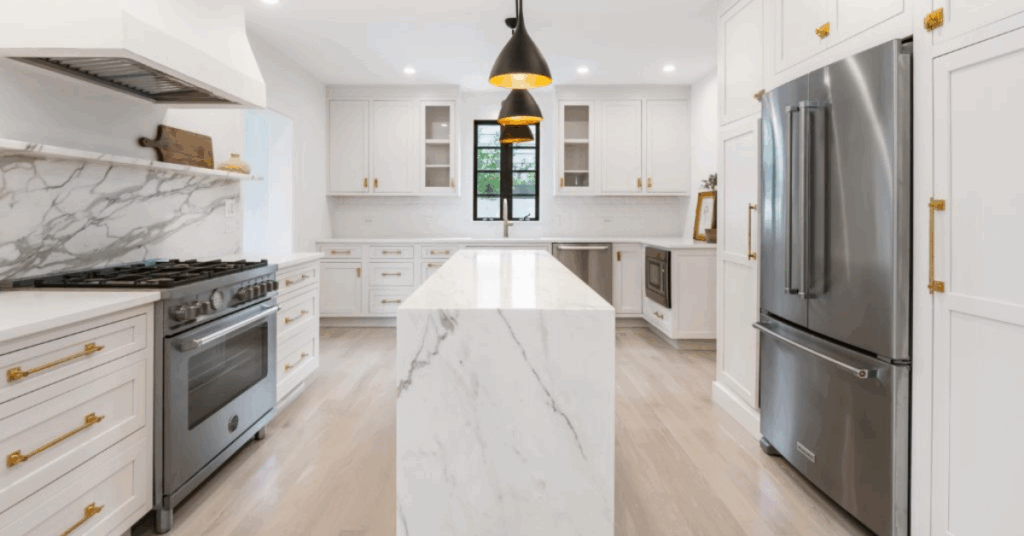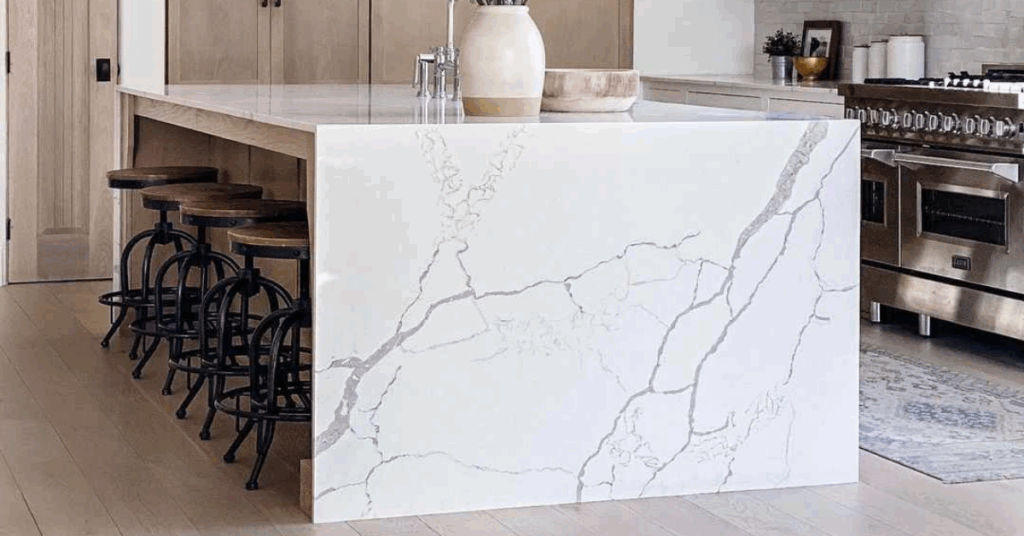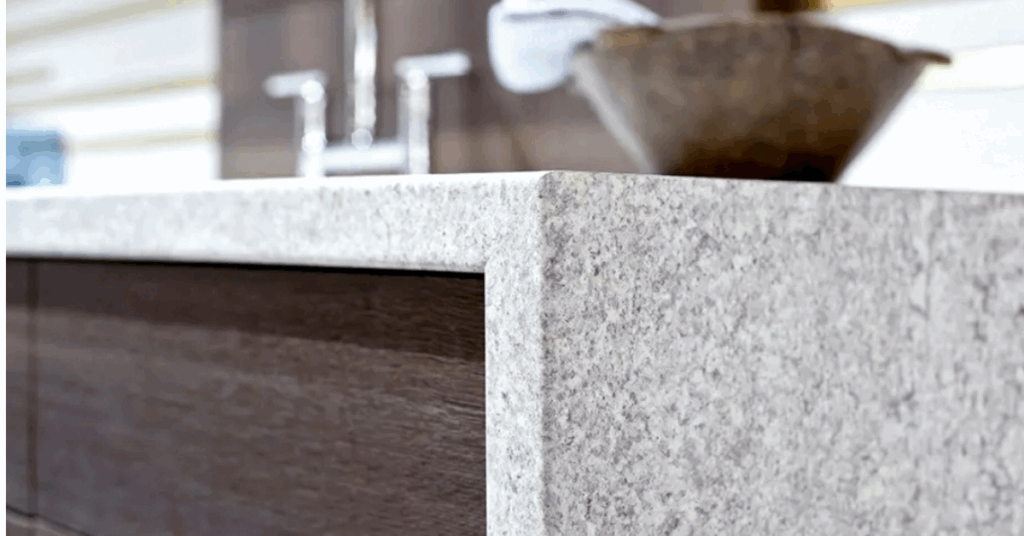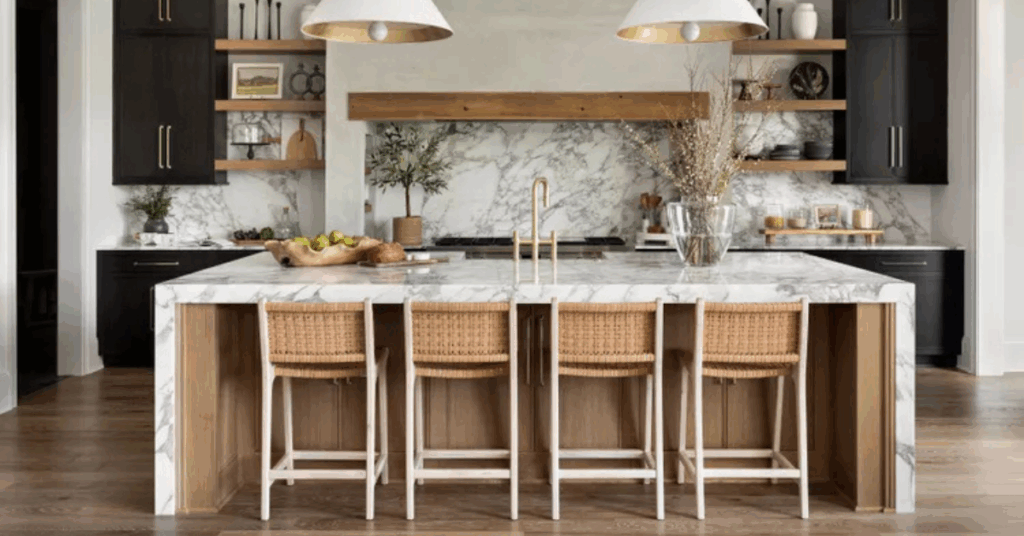Waterfall Edges: The Ultimate Guide to a Modern, Luxurious Countertop Design

Countertops are more than a work surface—they’re a defining design element in any kitchen, bathroom, or entertainment space. Among today’s most sought-after design features, waterfall edges have emerged as a favorite for homeowners, architects, and interior designers who want a look that is both striking and timeless.
Whether you’re planning a full kitchen remodel, updating a bathroom vanity, or designing an upscale bar, understanding waterfall edges will help you decide if this premium feature fits your project. At Masters Countertops in Chicagoland, we specialize in creating stunning waterfall countertops using advanced digital fabrication and a wide selection of natural and engineered stones.
This guide explains everything you need to know: what a waterfall edge is, the best materials to use, design tips, installation considerations, maintenance requirements, and why this elegant feature continues to dominate high-end kitchens and bathrooms.
What Is a Waterfall Edge?
A waterfall edge is a countertop design where the material flows vertically down the sides of cabinets or an island, creating the appearance of a continuous “waterfall” of stone. Instead of ending with a traditional horizontal overhang, the countertop slab extends to the floor, wrapping one or more sides of the cabinetry.
This seamless transition creates a sculptural, high-end look that showcases the beauty of the material. It’s especially popular on kitchen islands but can also be used on bathroom vanities, laundry rooms, home bars, and outdoor kitchens.
Why Waterfall Edges Are So Popular
The waterfall edge isn’t just a passing trend—it’s a design statement that offers style and function:
- Visual Drama: The continuous slab highlights the stone’s veining and pattern, making it the focal point of the room.
- Protection for Cabinets: The vertical slab shields cabinetry from scuffs, spills, and bumps.
- Luxury Appeal: Waterfall edges are associated with high-end kitchens and custom design, often increasing resale value.
- Versatility: Works with a variety of materials and styles, from modern minimalist to warm transitional designs.

Best Materials for Waterfall Countertops
Not every countertop material is ideal for a waterfall edge. Because the design showcases the stone so prominently, you need a durable material with consistent patterning and high-quality fabrication. Popular choices include:
Quartz
- Engineered for durability and available in countless colors and patterns.
- Non-porous and low-maintenance.
- Ideal for vein matching because slabs are more consistent.
- Perfect for busy kitchens where style and practicality must coexist.
Granite
- Natural beauty with unique patterns and colors.
- Heat and scratch resistant.
- Requires sealing to maintain stain resistance.
- Dramatic veining can create a one-of-a-kind waterfall effect.
Quartzite
- Combines the elegance of marble with the strength of granite.
- High-end designers love quartzite—especially popular options like Taj Mahal, which Masters Countertops carries in stock.
- Naturally heat-resistant and ideal for kitchens where durability is key.
Marble
- Timeless elegance and unmatched natural veining.
- Best for low-traffic kitchens, bathrooms, or decorative islands due to its higher maintenance needs.
- Sealing is required to reduce staining.
Porcelain
- Ultra-thin slabs for a sleek, modern look.
- UV-resistant and excellent for outdoor kitchens.
- Can mimic marble or concrete for a contemporary vibe.

Key Design Considerations
1. Vein Matching
A hallmark of a stunning waterfall edge is seamless vein continuation. Skilled fabricators like Masters Countertops use digital layout software to align patterns so the countertop’s veining flows naturally from the horizontal surface down the vertical side.
This meticulous process creates a dramatic, uninterrupted visual effect that elevates the entire space.
2. Edge Thickness
Most waterfall countertops use 2–3 cm slabs, but you can opt for mitered edges to create the illusion of a thicker surface. A mitered corner joins two pieces of stone at a 45-degree angle for a sharp, seamless look.
3. Single-Sided vs. Double-Sided
Waterfall edges can cover one side of an island, both sides, or even wrap around three sides for a full sculptural effect.
- Single-Sided: Offers a dramatic focal point while controlling cost.
- Double-Sided: Symmetrical and eye-catching, ideal for open-concept kitchens.
4. Cabinet and Flooring Coordination
Because the stone extends to the floor, you’ll want to ensure the cabinet base and flooring complement the material. Neutral flooring and simple cabinetry allow the waterfall to remain the star.
5. Functionality
Consider seating and workflow. Waterfall islands can double as breakfast bars or serving stations. If you plan to add stools, discuss overhang requirements with your fabricator.
Where to Use Waterfall Edges
Although most commonly featured on kitchen islands, waterfall edges can be used creatively throughout the home:
- Bathroom Vanities: Add drama to a master bath with a waterfall vanity in quartzite or marble.
- Laundry Rooms: Elevate a utilitarian space with a stylish waterfall folding station.
- Home Bars: Create a chic entertaining area with waterfall quartz or granite.
- Outdoor Kitchens: Use UV-resistant quartzite or porcelain for a seamless indoor-outdoor look.
- Fireplace Surrounds: Wrap a fireplace for a sleek, architectural statement.
Cost Factors
Waterfall edges are a premium feature and typically cost more than standard countertop installations. Factors influencing price include:
- Material Choice: High-end stones like quartzite or marble cost more than standard granite or quartz.
- Fabrication Complexity: Mitered edges and precise vein matching require advanced technology and skilled labor.
- Slab Size: Large islands may require multiple slabs to achieve full coverage.
- Installation Difficulty: Heavy vertical slabs require expert handling and secure anchoring.
At Masters Countertops, our per-square-foot pricing always includes premium 3 cm slabs, digital laser templating, CNC fabrication, eased edges, professional installation, dishwasher brackets, and caulking.
If additional charges apply—such as small-project fees for under 35 sq. ft. or long-distance delivery—our team will clearly communicate these costs upfront.
Maintenance and Cleaning
The good news: waterfall edges don’t require special maintenance beyond what’s recommended for the stone itself.
- Quartz & Porcelain: Clean with mild dish soap and water; no sealing required.
- Granite & Quartzite: Wipe daily with a pH-neutral cleaner; seal every 1–3 years.
- Marble: Use extra caution—clean spills immediately and reseal annually.
Because the stone extends to the floor, remember to clean vertical surfaces regularly to prevent scuffs from shoes or chairs.

Pairing Waterfall Edges with Other Design Elements
Countertops and Cabinets
For a bold, contemporary look, pair white waterfall quartz with deep navy or black cabinets.
For a softer, transitional style, try beige quartzite with warm wood cabinetry.
Countertops and Wall Paint
Pay attention to undertones. Warm stones like Taj Mahal quartzite pair beautifully with cream or taupe walls, while cool gray quartz complements navy or charcoal.
Countertops and Backsplash
Many homeowners opt for a matching slab backsplash to enhance the waterfall’s seamless look.
Trendy 2025 pairings include:
- Quartzite + zellige tile backsplash
- White quartz + bold patterned encaustic tile
- Granite + full-height stone backsplash
Outdoor Applications in Chicagoland
Waterfall edges aren’t limited to indoor kitchens. In the Midwest climate, quartzite and porcelain are excellent choices for outdoor kitchens because they resist UV rays, moisture, and freezing temperatures.
Proper sealing and seasonal maintenance help protect natural stone from Chicago’s cold winters.
Why Choose Masters Countertops for Your Waterfall Edge Project
Creating a flawless waterfall countertop requires advanced technology and skilled craftsmanship. At Masters Countertops:
- We use LT-2D3D laser measuring for exact templates.
- Our IRIS digital scanner ensures perfect vein matching.
- Robotic saws and CNC machines deliver precise mitered cuts and seamless edges.
- Our experienced team completes most projects in 7–14 days, keeping you informed every step of the way.
Whether you’re selecting from our in-stock materials or choosing a special-order slab from one of our trusted suppliers, we handle everything—from ordering to installation—with unmatched precision.
Final Thoughts
A waterfall edge isn’t just a countertop—it’s a design statement. This sleek, continuous style elevates any kitchen island, bathroom vanity, or bar into a work of art while protecting cabinetry and increasing home value.
From high-performance quartz to luxurious Taj Mahal quartzite, Masters Countertops has the materials, technology, and expertise to bring your waterfall vision to life. Visit our Wheeling, IL showroom to explore in-stock slabs, view real projects, and discuss your ideas with our design team.
Whether you’re remodeling a family kitchen or designing a custom outdoor space, a waterfall countertop can turn an ordinary surface into an unforgettable centerpiece.
Like what you see? Follow us for more design inspiration, expert tips, and the latest trends in natural stone and quartz countertops. Don’t forget to share!
